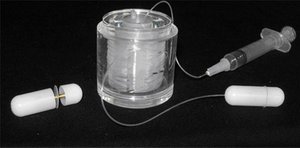
With a modification of the capsule, powder or other solid formulations may be administered. In this case, there is no metal tube and the thin tube is fastened directly to the proximal end of the capsule. The formulation is placed in front of a thin elastic membrane. When air is pressed through the open line, the membrane moves forward causing the capsule to open and the solid drug formulation will be expelled into the gut lumen.
The end of the thin tube outside the body is equipped with a Luer-loc fitting. The fitting is residing in a plastic reel, from which the tubing is gradually released. The plastic reel can be kept in a breast pocket during the study. From marks on the tube, the location of the capsule in the gut, in terms of centimetres from the nose, can be determined. The exact position in the gut can be verified by fluoroscopy or by injecting a gamma-emitting isotope, e g, 99m-Tc, for visualization with a gamma camera.
Intubation procedure: Before the capsule is attached to the soft tube, the latter is introduced through a nostril and passed through the nose until it is visible in the pharynx. Local anaesthesia of the pharynx, using a lignocaine spray, is generally given before the procedure. The tube is retrieved from the pharynx by a pair of tweezers and pulled out of the mouth, whereupon the capsule is fastened to the tube and swallowed with a glass of water. Then the subject has little further inconvenience and can easily eat and drink as allowed in the protocol.

Equipment (Figure): The method is based on intubation. It involves swallowing of a small plastic capsule (length 30 mm, diameter 10 mm) which, while being moved by peristalsis, pulls a thin soft tube (OD 0.6 mm) to the intended location in the human gut. The thin tube is inserted into and attached to a metal tube (X-ray visible) that runs through the length of the capsule. Hence an open line to any location in the gastrointestinal (GI) tract, even the distal colon, is created. At the intended destination, the capsule is stopped by fixating the tube to the cheek of the subject. Drug solution may then be administered as a bolus dose by a syringe or as a continuous infusion by a pump.